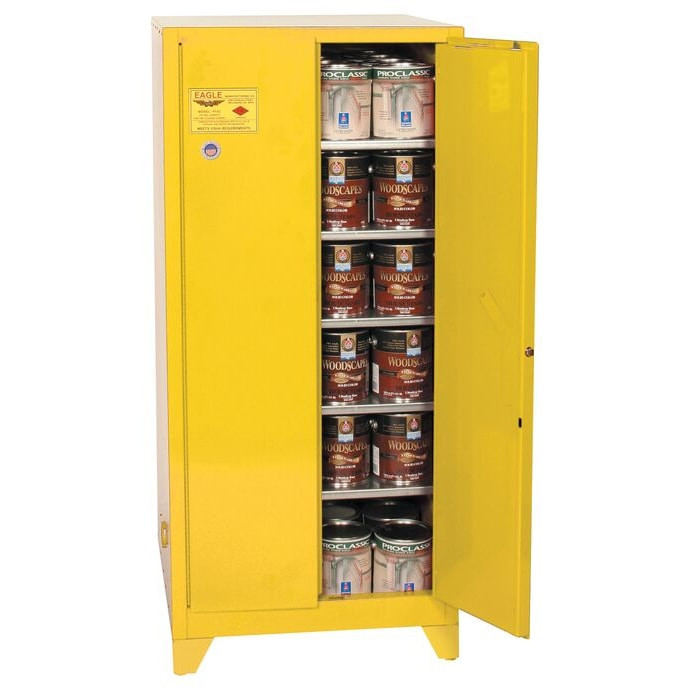Buying a Safety Cabinet? 3 Points to consider before you Purchase
Posted by EnSafeCo on 4th Dec 2023
Safety cabinets play a pivotal role in protecting your employees, your business and the environment from the potential hazards posed by corrosive, toxic or flammable substances.
These cabinets are meant to offer a controlled storage space intended to keep dangerous materials contained and isolated from potential sources of ignition or exposure.
In order to select the right cabinet for your needs, it is important to consider 3 major points before making a purchase. These include federal regulations, the type of door closing features and finally the color of the cabinet.


Regulations
Safety cabinets are purpose built for any business that manages, uses, stores or distributes dangerous materials. Unlike regular storage cabinets, safety cabinets comply with federal OSHA regulations and the National Fire Protection Association. Cabinets that comply with the NFPA will be marked with an “N” code and are manufactured to facilitate the safe storage of Class I, II and III flammable liquids.
Constructed with fire-resistant materials, these cabinets offer insulated double walls that act as a barrier and can prevent disastrous explosions by containing any fires that may occur with flammable substances stored inside.
Additionally, safety cabinets feature latching doors and ventilation systems meant to control fumes and prevent the accumulation of hazardous vapors.
Finally, regulated safety cabinets can also feature leak-proof sumps or trays ensuring that any leak or spill is contained within the cabinet, thus reducing the risk of contamination and enabling a quick and easy clean up.
Self-Closing VS Manual Closing
Both self-closing and manual closure options are available on safety cabinets. Self-closing doors have a spring-loaded mechanism that shuts the door when it is released, adding an extra layer of defense against unintentional exposure to hazardous materials. This feature is especially crucial in high-risk environments where human error or negligence may occur, leading to detrimental consequences. Conversely, manually closed doors require human effort to close and latch the door securely.
Before choosing one type of closing mechanism over another, take a moment to see if you are in a state that has adopted the International Fire Code (IFC) Standards, as these states require cabinets with doors that are self closing.
Ensafeco offers a wide variety of both options, which can be viewed at this link here.
Here is a list of the States that have adopted IFC:
- Alaska
- California
- Hawaii
- Idaho
- Montana
- Nevada
- North Carolina
- Oregon
- Utah
- Washington
Additionally, here is a list of the municipalities in other states that selectively require flammable safety cabinets to be fitted with self-closing doors to comply with safety regulations:
- Alabama
- Alaska
- Arizona
- Arkansas
- California
- Colorado
- Connecticut
- District of Columbia
- Georgia
- Hawaii
- Idaho
- Indiana
- Iowa
- Kansas
- Louisiana
- Maryland
- Massachusetts
- Minnesota
- Mississippi
- Missouri
- Montana
- Nevada
- New Jersey
- New Mexico
- New York
- North Carolina
- Ohio
- Oklahoma
- Oregon
- Pennsylvania
- South Carolina
- South Dakota
- Tennessee
- Texas
- Utah
- Virginia
- Washington
- Wisconsin
- Wyoming
The two standards regarding self closing doors in association with NFPA and IFC are:
- NFPA 1 (Uniform Fire Code) 66.9.4.3(2): “Doors shall be well fitted, self-closing, and equipped with a self-latching device.”
- IFC (International Fire Code) 5704.3.2.1.3: “Doors shall be well fitted, self-closing and equipped with a three-point latch.”
Cabinet Color
Color use and standardization encourages effective organization, reduces confusion and enhances workplace safety procedures. Although there are no regulations currently in place, many facilities have adopted a best practice approach when choosing cabinet color for their materials. This color- coded system allows for easy identification and the proper segregation of substances stored inside.
- Yellow: Flammable liquids
- Red: Paints, inks and other combustible liquids
- Gray or White: Waste or outdoor lockers
- Blue: Corrosives (acids, bases, oxidizers)
- Green: Pesticides and insecticides
- Silver or Neutral: Laboratory chemicals
In complying with this best practice, the risk of unintentionally storing incompatible materials together is greatly reduced and in the event of an incident occurring, will allow first responders to quickly and easily identify the type of contents inside in order to make informed decisions on their course of action.
Safety Cabinets are indispensable components in any facility where hazardous liquids or materials are handled.
By employing these cabinets, organizations prioritize the well-being of their employees, safeguard their assets, and protect the surrounding environment.
Ready to purchase your safety cabinet? Ensafeco offers a wide variety of models with brands such as Justrite, Eagle and Durham.
If you still have questions or need additional information about safety cabinets, check out our website or call our customer service desk - they will be happy to offer some guidance!

